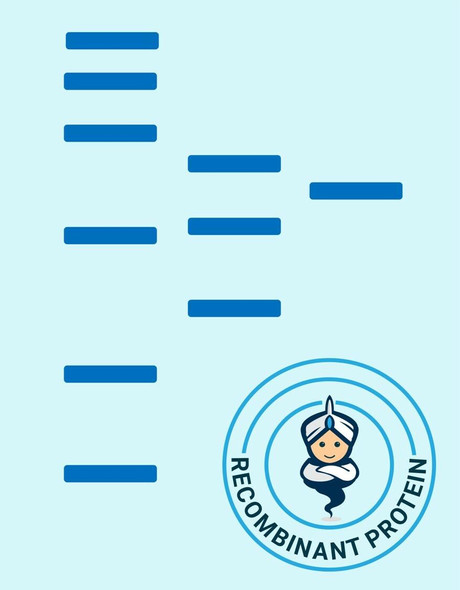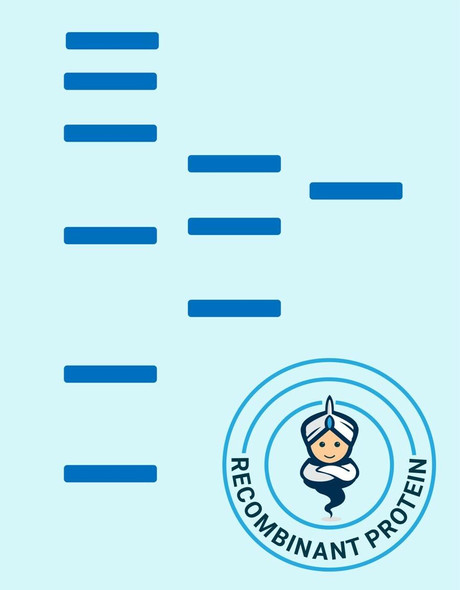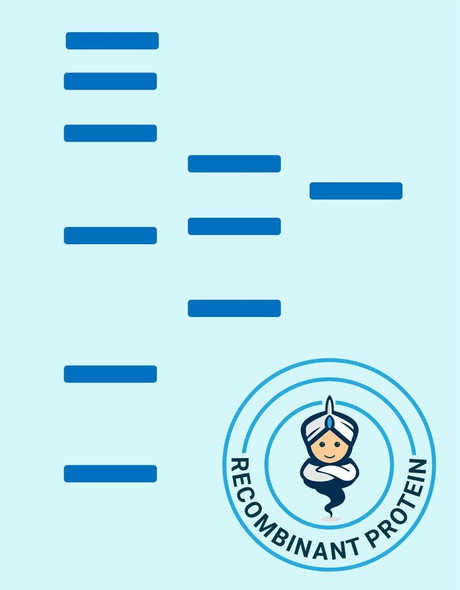Human PARP1 Recombinant Protein (RPPB2071)
- SKU:
- RPPB2071
- Product type:
- Recombinant Protein
- Size:
- 25ug
- Species:
- Human
- Target:
- PARP1
- Synonyms:
- ADPRT
- ADPRT1
- pADPRT
- pADPRT-1
- Source:
- Escherichia Coli
- Uniprot:
- P09874
Description
| Product Name: | Human PARP1 Recombinant Protein |
| Product Code: | RPPB2071 |
| Size: | 25µg |
| Species: | Human |
| Target: | PARP1 |
| Synonyms: | ADPRT, ADPRT1, pADPRT, pADPRT-1, PARP, PARP-1, PPOL, Poly [ADP-ribose] polymerase 1, NAD(+) ADP-ribosyltransferase 1, Poly[ADP-ribose] synthase 1, PARP1. |
| Source: | Escherichia Coli |
| Physical Appearance: | Sterile filtered colorless solution. |
| Formulation: | PARP1 solution containing 20mM Tris pH-8, 1mM DTT and 10% glycerol. |
| Stability: | Store at 4°C if entire vial will be used within 2-4 weeks. Store, frozen at -20°C for longer periods of time. For long term storage it is recommended to add a carrier protein (0.1% HSA or BSA).Avoid multiple freeze-thaw cycles. |
| Purity: | Greater than 95% as determined by SDS-PAGE. |
| Amino Acid Sequence: | MKSKLPKPVQ DLIKMIFDVE SMKKAMVEYE IDLQKMPLGK LSKRQIQAAY SILSEVQQAV SQGSSDSQIL DLSNRFYTLI PHDFGMKKPP LLNNADSVQA KAEMLDNLLD IEVAYSLLRG GSDDSSKDPI DVNYEKLKTD IKVVDRDSEE AEIIRKYVKN THATTHNAYD LEVIDIFKIE REGECQRYKP FKQLHNRRLL WHGSRTTNFA GILSQGLRIA PPEAPVTGYM FGKGIYFADM VSKSANYCHT SQGDPIGLIL LGEVALGNMY ELKHASHISK LPKGKHSVKG LGKTTPDPSA NISLDGVDVP LGTGISSGVN DTSLLYNEYI VYDIAQVNLK YLLKLKFNFK TSLW |
PARP1 takes part in the base excision repair pathway, by catalyzing the poly ADP-ribosyl of a restricted number of acceptor proteins involved in chromatin architecture and in DNA metabolism.. PARP1 mediates the poly ADP-ribosy of APLF and CHFR. PARP1 positively regulates the transcription of MTUS1 and negatively regulates the transcription of MTUS2/TIP150. PARP1 is a chromatin-associated enzyme, poly (ADP-ribosyl) transferase, which modifies various nuclear proteins by poly ADP-ribosyl. PARP1 takes part in the regulation of various significant cellular processes such as differentiation, proliferation, and tumor transformation and also in the regulation of the molecular events involved in the recovery of cell from DNA damage. PARP1 is a site of mutation in Fanconi anemia, and is involved in the pathophysiology of type I diabetes.
PARP1 Human Recombinant produced in E.Coli is a single, non-glycosylated,polypeptide chain containing 354 amino acids (662-1014a.a.) and having a molecular mass of 39.6 kDa. PARP1 is purified by proprietary chromatographic techniques.
| UniProt Protein Function: | PARP1: Involved in the base excision repair (BER) pathway, by catalyzing the poly(ADP-ribosyl)ation of a limited number of acceptor proteins involved in chromatin architecture and in DNA metabolism. This modification follows DNA damages and appears as an obligatory step in a detection/signaling pathway leading to the reparation of DNA strand breaks. Mediates the poly(ADP- ribosyl)ation of APLF and CHFR. Positively regulates the transcription of MTUS1 and negatively regulates the transcription of MTUS2/TIP150. With EEF1A1 and TXK, forms a complex that acts as a T-helper 1 (Th1) cell-specific transcription factor and binds the promoter of IFN-gamma to directly regulate its transcription, and is thus involved importantly in Th1 cytokine production. Component of a base excision repair (BER) complex, containing at least XRCC1, PARP2, POLB and LRIG3. Homo- and heterodimer with PARP2. Interacts with PARP3, APTX and SRY. The SWAP complex consists of NPM1, NCL, PARP1 and SWAP70. Interacts with TIAM2 and ZNF423. Interacts (when poly-ADP- ribosylated) with CHD1L. Interacts with the DNA polymerase alpha catalytic subunit POLA1; this interaction functions as part of the control of replication fork progression. Interacts with EEF1A1, RNF4 and TXK. |
| UniProt Protein Details: | Protein type:DNA repair, damage; EC 2.4.2.30; Nuclear envelope; Nuclear receptor co-regulator; Nucleolus; Transferase Chromosomal Location of Human Ortholog: 1q42.12 Cellular Component: membrane; mitochondrion; nuclear chromosome, telomeric region; nuclear envelope; nucleolus; nucleoplasm; nucleus; protein complex; transcription factor complex Molecular Function:DNA ligase (ATP) activity; enzyme binding; identical protein binding; NAD+ ADP-ribosyltransferase activity; protein binding; protein kinase binding; protein N-terminus binding; RNA binding; transcription factor binding Biological Process: cellular response to insulin stimulus; DNA ligation during DNA repair; DNA repair; double-strand break repair; double-strand break repair via homologous recombination; lagging strand elongation; macrophage differentiation; mitochondrial DNA metabolic process; mitochondrial DNA repair; mitochondrion organization and biogenesis; negative regulation of transcription from RNA polymerase II promoter; nucleotide-excision repair, DNA damage recognition; nucleotide-excision repair, DNA duplex unwinding; nucleotide-excision repair, DNA incision; nucleotide-excision repair, DNA incision, 3'-to lesion; nucleotide-excision repair, DNA incision, 5'-to lesion; nucleotide-excision repair, preincision complex assembly; nucleotide-excision repair, preincision complex stabilization; peptidyl-serine ADP-ribosylation; protein amino acid ADP-ribosylation; regulation of catalytic activity; response to DNA damage stimulus; telomere maintenance; transcription from RNA polymerase II promoter |
| NCBI Summary: | This gene encodes a chromatin-associated enzyme, poly(ADP-ribosyl)transferase, which modifies various nuclear proteins by poly(ADP-ribosyl)ation. The modification is dependent on DNA and is involved in the regulation of various important cellular processes such as differentiation, proliferation, and tumor transformation and also in the regulation of the molecular events involved in the recovery of cell from DNA damage. In addition, this enzyme may be the site of mutation in Fanconi anemia, and may participate in the pathophysiology of type I diabetes. [provided by RefSeq, Jul 2008] |
| UniProt Code: | P09874 |
| NCBI GenInfo Identifier: | 130781 |
| NCBI Gene ID: | 142 |
| NCBI Accession: | P09874.4 |
| UniProt Secondary Accession: | P09874,Q8IUZ9, B1ANJ4, |
| UniProt Related Accession: | P09874 |
| Molecular Weight: | 113kDa |
| NCBI Full Name: | Poly |
| NCBI Synonym Full Names: | poly(ADP-ribose) polymerase 1 |
| NCBI Official Symbol: | PARP1 |
| NCBI Official Synonym Symbols: | PARP; PPOL; ADPRT; ARTD1; ADPRT1; PARP-1; ADPRT 1; pADPRT-1 |
| NCBI Protein Information: | poly [ADP-ribose] polymerase 1 |
| UniProt Protein Name: | Poly [ADP-ribose] polymerase 1 |
| UniProt Synonym Protein Names: | ADP-ribosyltransferase diphtheria toxin-like 1; ARTD1; NAD(+) ADP-ribosyltransferase 1; ADPRT 1; Poly[ADP-ribose] synthase 1 |
| Protein Family: | Poly [ADP-ribose] polymerase |
| UniProt Gene Name: | PARP1 |










